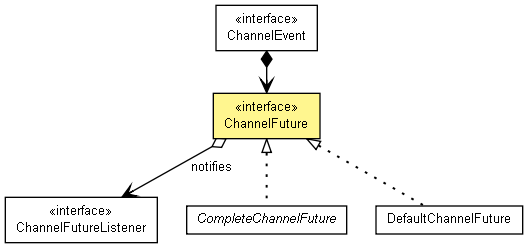
|
|||||||||
| 上一个类 下一个类 | 框架 无框架 | ||||||||
| 摘要: 嵌套 | 字段 | 构造方法 | 方法 | 详细信息: 字段 | 构造方法 | 方法 | ||||||||
public interface ChannelFuture

一个通道的异步 I/O操作结果.
在Netty里所有I/O操作都是异步的. 这意味着任何I/O操作都不会保证I/O请求在调用后完成,而是会立即返回.相反,会返回一个
ChannelFuture实例 以提供该I/O操作的结果或状态信息.
一个ChannelFuture要么未完成要么完成.
当I/O操作开始,一个新的future对象就被创建.一个future初始是未完成的 -
因为I/O操作还没有结束,它既不是成功,失败也不是取消.如果I/O操作已经完成,要么成功或失败,要么取消
,使用更多的信息标识future为完成,如发生失败 .请注意失败和取消也属于完成状态.
+---------------------------+
| 成功完成 |
+---------------------------+
+----> isDone() = true |
+--------------------------+ | | isSuccess() = true |
| 未完成 | | +===========================+
+--------------------------+ | | 失败完成 |
| isDone() = false | | +---------------------------+
| isSuccess() = false |----+----> isDone() = true |
| isCancelled() = false | | | getCause() = non-null |
| getCause() = null | | +===========================+
+--------------------------+ | | 取消完成 |
| +---------------------------+
+----> isDone() = true |
| isCancelled() = true |
+---------------------------+
有各种各样的方法可以让你检测I/O的已经完成 , 等待完成和取回I/O操作结果. 它也允许你添加
ChannelFutureListener以便当I/O操作完成你可以收到通知.
addListener(ChannelFutureListener)比await()更好addListener(ChannelFutureListener),再使用await()
,因为不管在什么地方,当I/O操作完成你都可以收到通知,并执行后续任务.
addListener(ChannelFutureListener)是非阻塞的.它简单的为
ChannelGroupFuture添加特定的ChannelGroupFutureListener
,并且当该future关联的I/O操作完成后I/O线程会通知这些监听器.由于它是不阻塞的,所以ChannelFutureListener
有最好的性能和资源利用率, 但是如果你不是使用事件驱动编程,它实现顺序逻辑就很棘手.
相比之下, await()是阻塞操作.一旦调用,调用线程会阻塞直到所有I/O操作完成为止.虽然使用await()
可以很简单的实现一个顺序逻辑
,但是调用线程会不必要的阻塞直到所有I/O操作完成和相当昂贵的交互线程通知的开销.而且,在特别情况下还有可能会出现死锁,如下所描述.
ChannelHandler里面调用await()
ChannelHandler的事件处理方法会经常被I/O线程调用,除了ChannelPipeline里的
ExecutionHandler.如果await()
被一个I/O线程调用的事件处理方法调用,该I/O操作会是一个永远不会完成一直等待的操作,因为await()
会阻塞该I/O操作,所以是一个死锁.
// BAD - 别这么做@Overridepublic void messageReceived(ChannelHandlerContextctx,MessageEvente) { if (e.getMessage() instanceof GoodByeMessage) {ChannelFuturefuture = e.getChannel().close(); future.awaitUninterruptibly(); // Perform post-closure operation // ... } } // GOOD@Overridepublic void messageReceived(ChannelHandlerContextctx,MessageEvente) { if (e.getMessage() instanceof GoodByeMessage) {ChannelFuturefuture = e.getChannel().close(); future.addListener(newChannelFutureListener() { public void operationComplete(ChannelFuturefuture) { // Perform post-closure operation // ... } }); } }
尽管有以上提到的缺点,在某些情况下,调用await()会更方便.在这种情况下,请确保你没有在一个I/O线程里调用
await().否则,会抛出IllegalStateException异常以防止死锁.
await(long), await(long, TimeUnit),
awaitUninterruptibly(long), or
awaitUninterruptibly(long, TimeUnit)
指定的超时值与I/O超时一点关系都没有.如果一个I/O操作超时,该future会被标识为 '完成失败'
正如上图所描述.例如,连接超时应该通过传输属性来制定:
// BAD - 别这么做ClientBootstrapb = ...;ChannelFuturef = b.connect(...); f.awaitUninterruptibly(10, TimeUnit.SECONDS); if (f.isCancelled()) { // Connection attempt cancelled by user } else if (!f.isSuccess()) { // You might get a NullPointerException here because the future // might not be completed yet. f.getCause().printStackTrace(); } else { // Connection established successfully } // GOODClientBootstrapb = ...; // Configure the connect timeout option. b.setOption("connectTimeoutMillis", 10000);ChannelFuturef = b.connect(...); f.awaitUninterruptibly(); // Now we are sure the future is completed. assert f.isDone(); if (f.isCancelled()) { // Connection attempt cancelled by user } else if (!f.isSuccess()) { f.getCause().printStackTrace(); } else { // Connection established successfully }
| 方法摘要 | |
|---|---|
void |
addListener(ChannelFutureListener listener)
添加指定的监听器到该future.当该future完成 ,该监听器会收到通知.如果该future已经完成,指定的监听器也会立刻收到通知. |
ChannelFuture |
await()
等待该future完成 |
boolean |
await(long timeoutMillis)
在指定的时间限制内等待future的完成. |
boolean |
await(long timeout,
java.util.concurrent.TimeUnit unit)
在指定的时间限制内等待future的完成. |
ChannelFuture |
awaitUninterruptibly()
等待该future完成.该方法会捕捉 InterruptedException并安静丢弃. |
boolean |
awaitUninterruptibly(long timeoutMillis)
在指定的时间限制内等待future的完成.该方法会捕捉 InterruptedException并丢弃异常. |
boolean |
awaitUninterruptibly(long timeout,
java.util.concurrent.TimeUnit unit)
在指定的时间限制内等待future的完成.该方法会捕捉 InterruptedException并丢弃异常. |
boolean |
cancel()
取消该future关联的I/O操作,如果取消成功则通知所有监听器. |
java.lang.Throwable |
getCause()
如果I/O操作失败,则返回导致I/O操作失败的原因. |
Channel |
getChannel()
返回该future关联发生I/O操作的Channel. |
boolean |
isCancelled()
只有该future被使用 cancel()方法取消才返回true. |
boolean |
isDone()
只有当该future完成了返回true,不管操作是否成功、失败或取消. |
boolean |
isSuccess()
只有该future的I/O操作成功完成才返回true. |
void |
removeListener(ChannelFutureListener listener)
移除该future里指定的监听器.当该future完成 ,该监听器会收到通知.如果指定的监听器不再关联该future,该方法不做任何事. |
boolean |
setFailure(java.lang.Throwable cause)
标识该future为失败并通知所有监听器. |
boolean |
setProgress(long amount,
long current,
long total)
通知实现 ChannelFutureProgressListener接口的监听器该操作的进度. |
boolean |
setSuccess()
标识该future为成功并通知所有监听器. |
| 方法详细信息 |
|---|
Channel getChannel()
boolean isDone()
boolean isCancelled()
cancel()方法取消才返回true.
boolean isSuccess()
java.lang.Throwable getCause()
null.boolean cancel()
true.如果操作不被取消或已经完成则返回false.boolean setSuccess()
true.如果该future已经被标识过成功或失败则返回
false.boolean setFailure(java.lang.Throwable cause)
true.如果该future已经被标识过成功或失败则返回
false.
boolean setProgress(long amount,
long current,
long total)
ChannelFutureProgressListener接口的监听器该操作的进度.
请注意如果该future已经完成则该方法不会做任何事直接返回false.
true if and only if notification was made.void addListener(ChannelFutureListener listener)
void removeListener(ChannelFutureListener listener)
ChannelFuture await()
throws java.lang.InterruptedException
java.lang.InterruptedException - 如果当前线程被打断则抛出异常ChannelFuture awaitUninterruptibly()
InterruptedException并安静丢弃.
boolean await(long timeout,
java.util.concurrent.TimeUnit unit)
throws java.lang.InterruptedException
java.lang.InterruptedException - 如果当前线程被打断则抛出异常
boolean await(long timeoutMillis)
throws java.lang.InterruptedException
java.lang.InterruptedException - 如果当前线程被打断则抛出异常
boolean awaitUninterruptibly(long timeout,
java.util.concurrent.TimeUnit unit)
InterruptedException并丢弃异常.
boolean awaitUninterruptibly(long timeoutMillis)
InterruptedException并丢弃异常.
|
|||||||||
| 上一个类 下一个类 | 框架 无框架 | ||||||||
| 摘要: 嵌套 | 字段 | 构造方法 | 方法 | 详细信息: 字段 | 构造方法 | 方法 | ||||||||